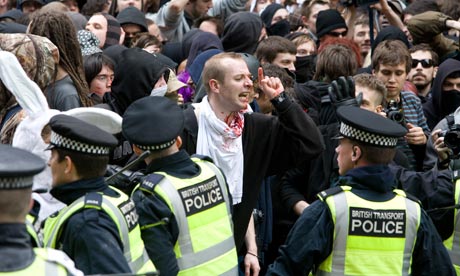Jury acquits G20 protester accused of being ringleader in clashes
Crown court clears Harvie Brown of violent disorder in case that challenged police version of events

His bloodied face became the symbol of violent G20 demonstrators seemingly intent on attacking police. But the man whose angry remonstrations with police at the protests in April last year were relayed live on television news, and later emblazoned across newspaper front pages, was not the rioter he was depicted as.
A jury at Isleworth crown court in Middlesex took 30 minutes to clear Harvie Brown, 31, of violent disorder this week, in a case that challenged the police version of events and established that his injuries were probably inflicted by officers.
Brown was among several hundred protesters "kettled" by police near the Bank of England on 1 April last year. Attempts to contain anti-capitalist and green activists inside cordons led to angry confrontations and clashes.
Brown was caught between lines of baton-wielding police attempting to push the crowd back. Many at the front, including Brown, from Glasgow, were unable to obey the police orders as the agitated crowd behind them tried to surge forward. Many were struck with batons.
The court heard Brown's injuries – two head wounds and a broken tooth – could have been inflicted by police.
In court, Brown was accused of being the ringleader of an aggressive group of rioters, encouraging the crowd to attack police officers – a charge he denied. He faced three years in jail if found guilty.
Initial press reports suggested Brown was goading officers into a confrontation.
"I was shocked when I was released from the police station in the early hours of 2 April to see that I was plastered all over the newspapers and described as a violent agitator at the G20 protests," Brown said tonight.
"I was distressed that I was made out to be the aggressor. I was also very upset that the emphasis of the reporting, which I felt should have been on the demonstration against the causes of the financial crisis, had turned into a focus on what was described as anti-police behaviour."
Witnesses told the court that Brown spent much of the protest distressed and in tears, upset at police treatment.
Rhona Friedman, defending, said: "This was a prosecution that should never have been brought. Footage and photographs show that Mr Brown was repeatedly struck by police officers without resorting to violent retaliation. "Members of the jury were seen to flinch at footage of police officers deploying baton strikes against people in the crowd. When asked to decide who was guilty of unlawful violence and who was not, the jury could not have more clearly decided in Mr Brown's favour."
Despite initial claims by police about violence caused by protesters G20, there have been relatively few convictions for a demonstration of its size.
Seven people have so far been convicted of violent conduct, criminal damage and public order offences at or during the demonstration, including a handful who were identified as having taken part in the ransacking of a branch of the Royal Bank of Scotland. A further five prosecutions are pending, while five have resulted in acquittals.
Prosecutors dropped charges in their largest case, which involved 11 members of the Space Hijackers, an anarchist group whose members arrived at G20 protests in a tank, dressed in police-style helmets and boiler suits. The activists, some wearing red stockings, were arrested and charged with impersonating police officers. They are suing the Met for wrongful arrest and false imprisonment.